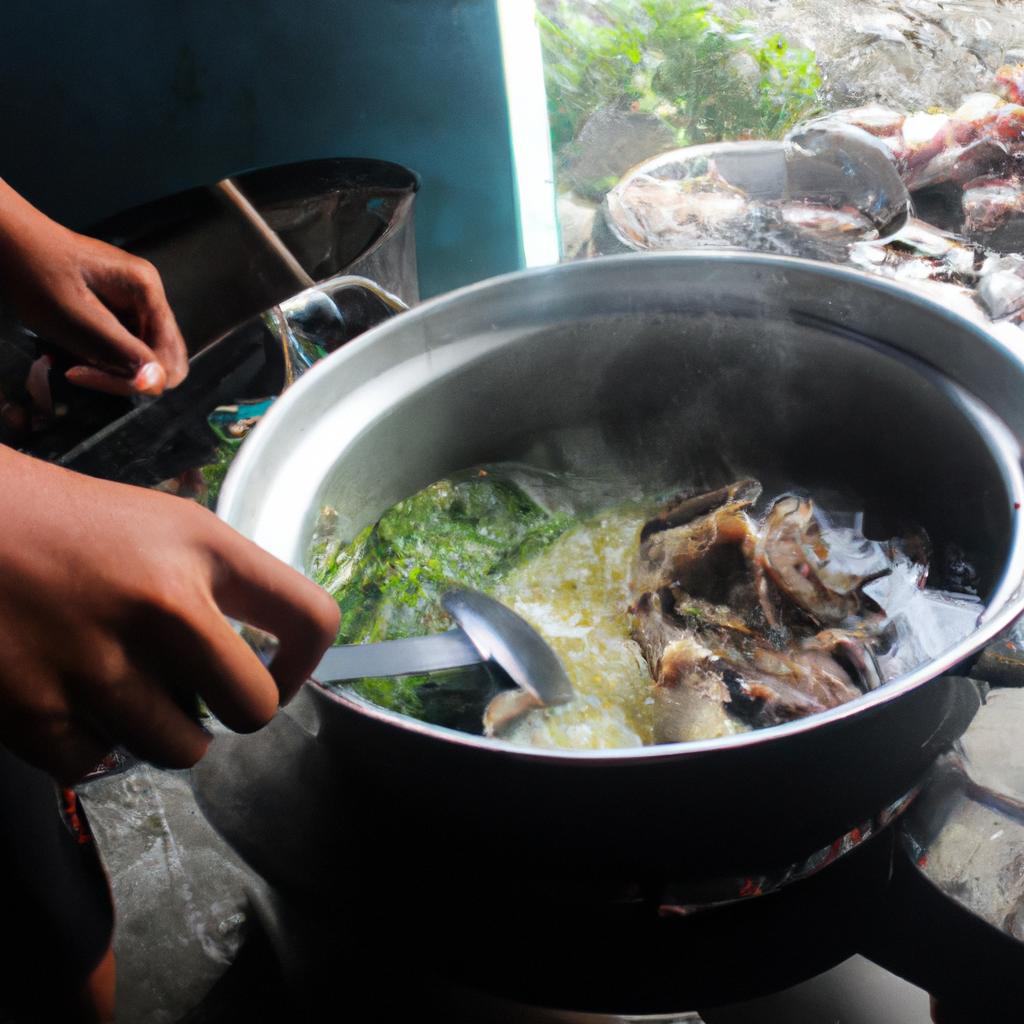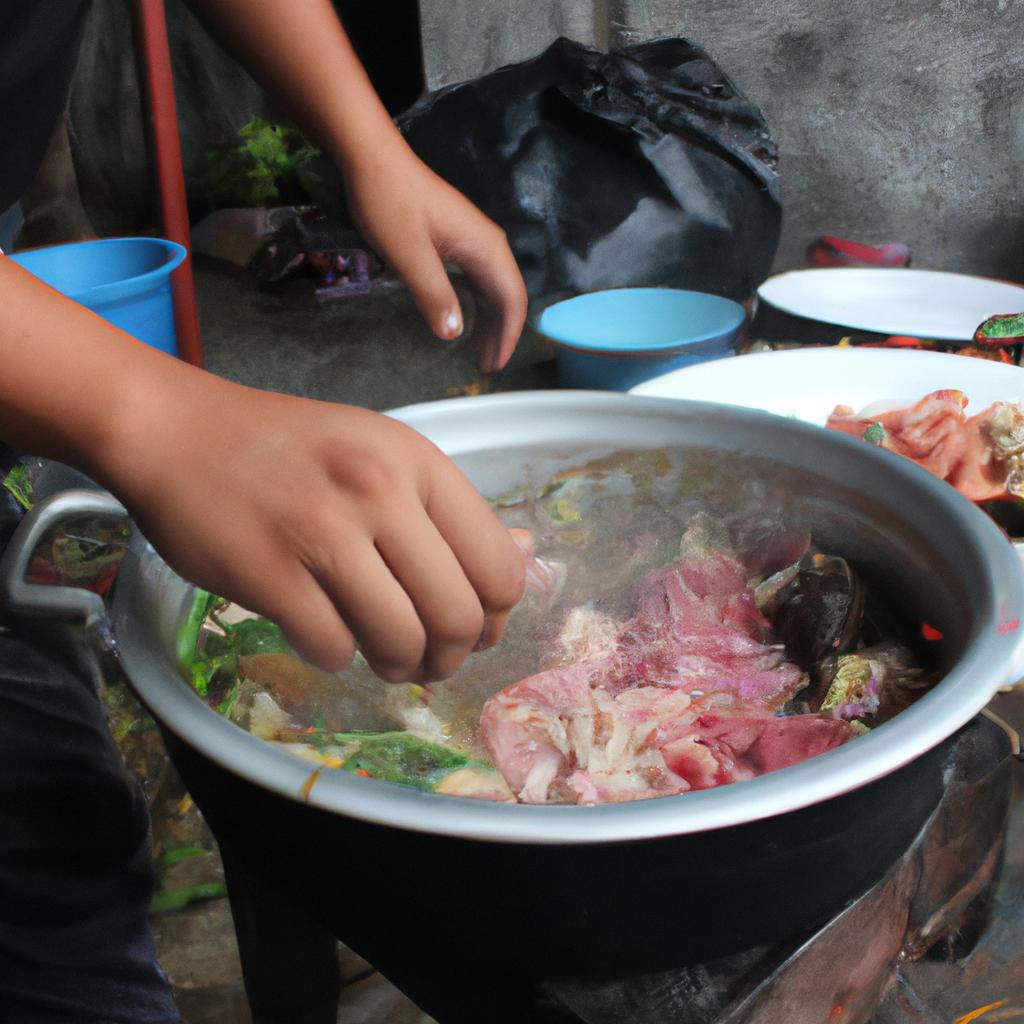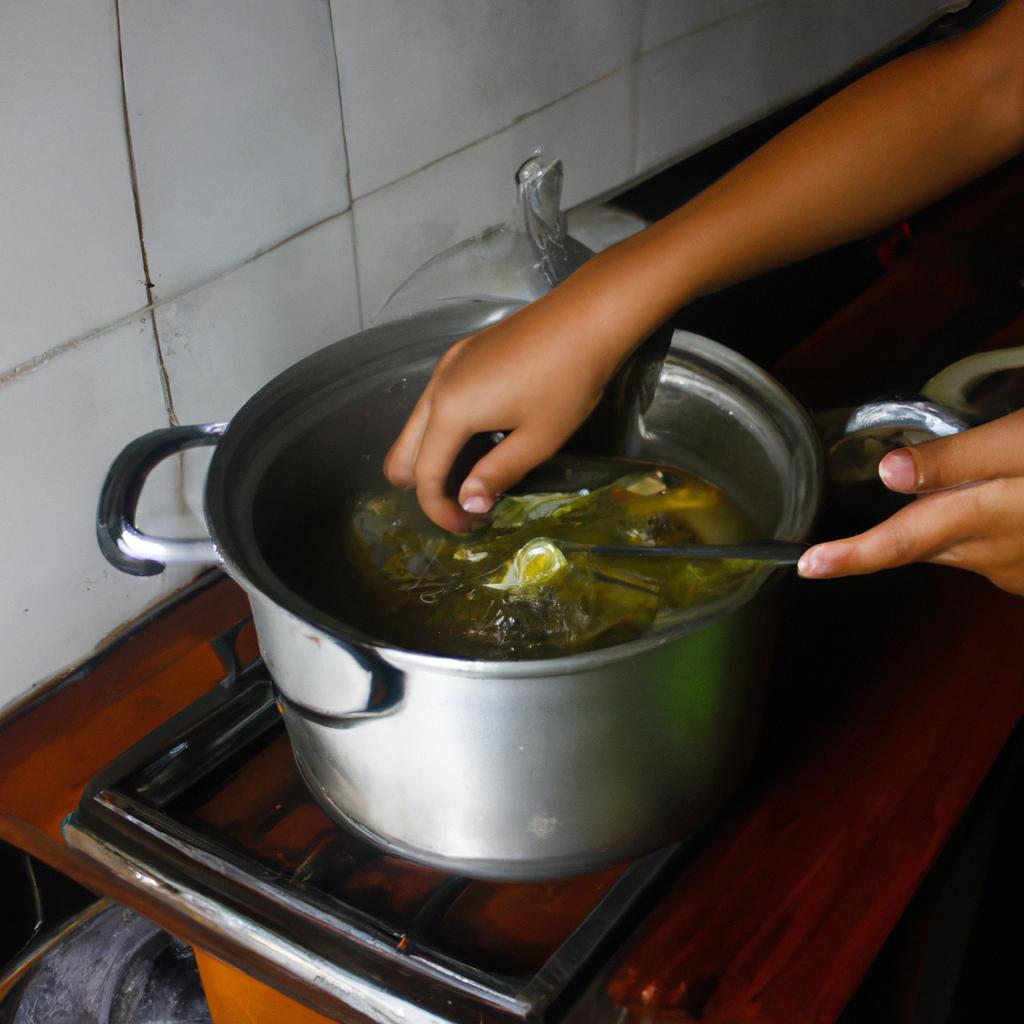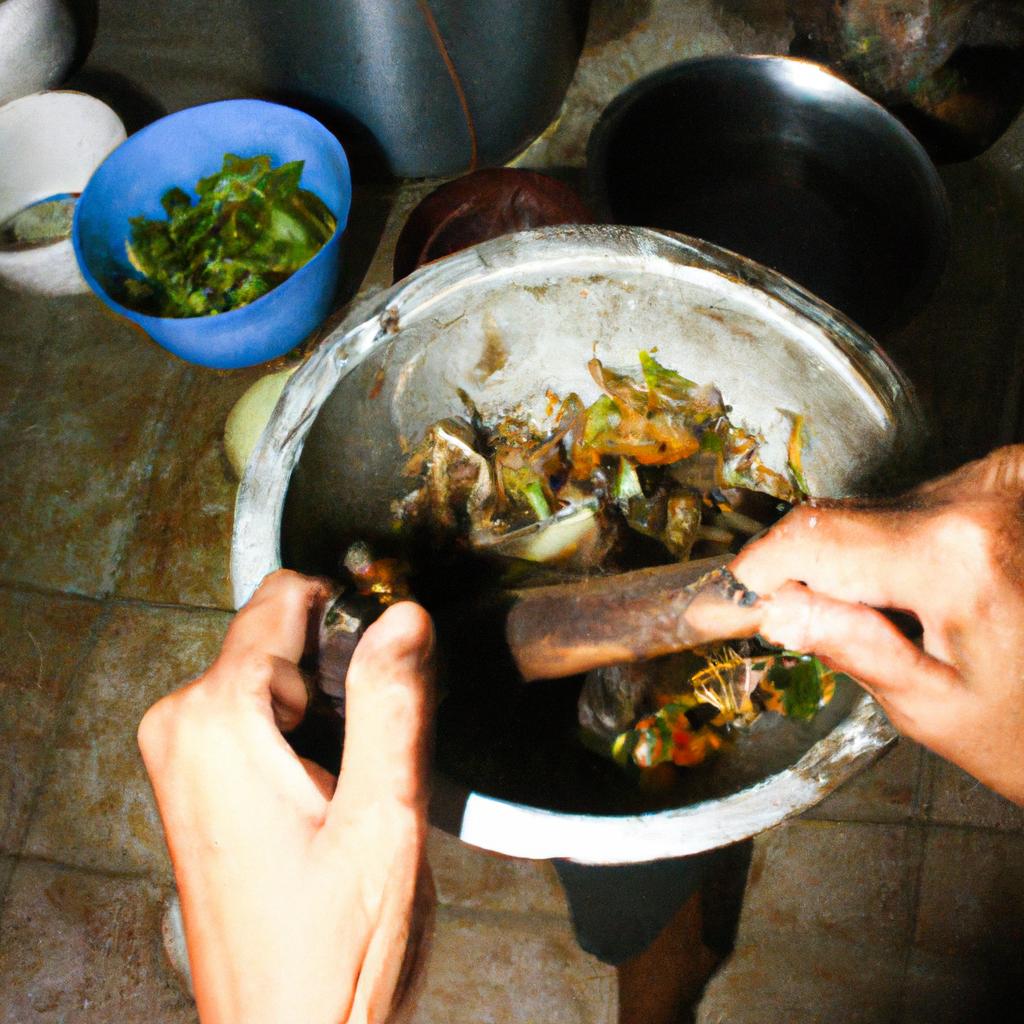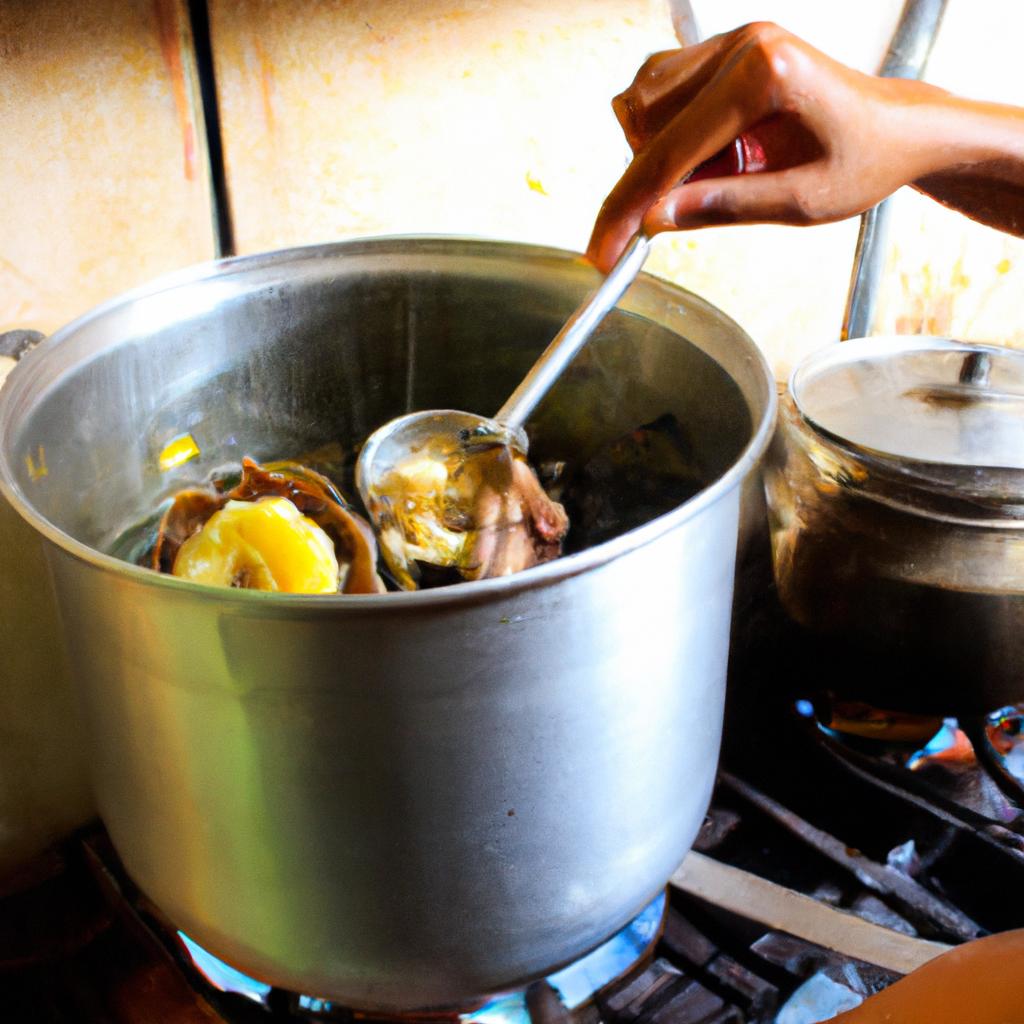Filipino cuisine is known for its diverse range of flavorful delicacies, each prepared using unique cooking methods that highlight the rich cultural heritage of the country. One such mouthwatering dish is Bulalo, a traditional Filipino soup made from beef shanks and bone marrow. This article explores the different cooking techniques employed in preparing this delectable dish, shedding light on the intricate process behind its creation.
Imagine yourself sitting in a cozy Filipino restaurant as you indulge your senses in the tantalizing aroma emanating from a simmering pot of Bulalo. The sight of tender beef shanks immersed in a savory broth, accompanied by an array of vegetables and spices, is enough to make any food enthusiast’s mouth water. But what goes into making this beloved Filipino delicacy? To truly appreciate the flavors and textures brought about by Bulalo, it is essential to understand the various cooking methods utilized during its preparation.
In order to unlock the full potential of flavor hidden within every ingredient, Filipinos employ several cooking techniques when creating their beloved Bulalo. From boiling and simmering to braising and stewing, each method contributes its own unique touch to enhance the taste profile of this renowned dish. By delving into these culinary practices, we can explore not only how these techniques are executed, but also the reasons behind their use.
First and foremost, boiling is a fundamental step in preparing Bulalo. This involves submerging the beef shanks and bone marrow in water and bringing it to a vigorous boil. Boiling helps to tenderize the meat, allowing it to become succulent and easily fall off the bone. Additionally, this process helps to extract the flavors from the bones, creating a rich and robust broth that forms the foundation of Bulalo’s distinctive taste.
Simmering is another crucial technique employed in cooking Bulalo. Once the initial boiling phase is complete, the heat is reduced to a gentle simmer. This extended period of slow cooking allows the flavors of the ingredients to meld together harmoniously while ensuring that the meat remains tender. Simmering also aids in intensifying the depth of flavor by reducing excess liquid and concentrating the essence of each component.
Braising plays a significant role in enhancing both texture and taste when preparing Bulalo. After boiling and simmering, some variations call for searing or browning the beef shanks before returning them to the pot with additional ingredients such as onions, garlic, and spices. The process of braising allows these flavors to infuse into every fiber of meat while adding complexity through caramelization.
Lastly, stewing brings all elements together in perfect harmony. By combining various vegetables like corn cobs, cabbage, potatoes, and beans with the already tenderized beef shanks and flavorful broth, Bulalo achieves a wholesome balance between protein-rich components and hearty vegetables. Stewing ensures that all ingredients are fully cooked while allowing them to absorb one another’s flavors.
In conclusion, making Bulalo involves several cooking techniques that contribute to its unique taste experience. From boiling to simmering, braising to stewing; each method plays a vital role in achieving tender meat, flavorful broth, and well-incorporated ingredients. Next time you savor a bowl of Bulalo, you can appreciate the intricate process behind its creation and the artistry required to bring out its full potential.
What is Bulalo?
Bulalo is a traditional Filipino delicacy that originated from the province of Batangas. This hearty soup dish has gained popularity not only in the Philippines but also among food enthusiasts worldwide. It is known for its rich and flavorful broth made by simmering beef shanks and marrow bones for several hours, resulting in tender meat and gelatinous bone marrow.
To illustrate the appeal of Bulalo, let us consider an example: imagine walking into a cozy restaurant on a rainy evening with the aroma of simmering beef wafting through the air. As you take your seat, you notice other diners eagerly sipping spoonfuls of steaming hot Bulalo, their faces lighting up with satisfaction. Intrigued by this scene, you decide to order a bowl yourself.
The experience of enjoying Bulalo goes beyond taste and nourishment; it evokes emotions tied to comfort and warmth. Here are some reasons why this Filipino delicacy holds such a special place in people’s hearts:
- Nostalgia: For many Filipinos, Bulalo brings back memories of family gatherings or childhood visits to local eateries where they first tasted this delectable dish.
- Satisfaction: The combination of succulent beef, melt-in-your-mouth bone marrow, and savory broth creates a truly satisfying culinary experience.
- Cultural heritage: Bulalo represents the richness of Filipino cuisine and serves as a symbol of tradition that has been passed down through generations.
- Sense of community: Sharing a large pot of Bulalo with loved ones fosters camaraderie and strengthens bonds within families and communities.
| Emotions Evoked by Bulalo |
|---|
| Nostalgia |
| Satisfaction |
| Cultural heritage |
| Sense of community |
As we delve further into exploring the world of Bulalo, it becomes evident that understanding its traditional ingredients plays a crucial role in appreciating its authentic flavor.
Transitioning into the subsequent section about “Traditional Ingredients for Bulalo,” we will explore the key components that contribute to this beloved Filipino delicacy.
Traditional Ingredients for Bulalo
Bulalo, a Filipino delicacy known for its rich and flavorful broth, offers not only a delectable culinary experience but also numerous health benefits. To better appreciate the nutritional value of this dish, let’s explore some key aspects that contribute to its overall goodness.
A Hearty Source of Protein
Protein is an essential nutrient needed by our bodies for growth and repair. In the case of bulalo, the main source of protein comes from the beef shanks used in the broth. These succulent cuts provide a substantial amount of amino acids necessary for tissue development and maintenance. Incorporating bulalo into your diet can thus assist in meeting your daily protein requirements.
Rich in Vitamins and Minerals
Bulalo contains various vitamins and minerals vital for optimal bodily functions. Some notable examples include:
- Calcium: Beef bones used in making bulalo release calcium during cooking, contributing to bone strength.
- Iron: The presence of iron helps promote healthy red blood cell production.
- Vitamin B12: This vitamin aids in neurological function and plays a crucial role in DNA synthesis.
- Phosphorus: Phosphorus supports energy metabolism and assists in maintaining proper cellular functioning.
These nutrients work together to support overall well-being, making bulalo not just a delicious dish but also a nutritious one.
Hydration Benefits
Aside from being packed with essential nutrients, another advantage offered by bulalo is hydration. Since it is primarily composed of soup or broth, consuming this Filipino delicacy can help replenish fluids lost throughout the day due to perspiration or other bodily processes. Staying hydrated is important for various physiological functions such as temperature regulation, digestion, and circulation.
To summarize, indulging in a warm bowl of bulalo provides both gastronomic satisfaction and valuable nutrition. Its high protein content, abundance of vitamins and minerals, along with its hydrating properties, make it a wholesome addition to any diet.
Preparation of Bulalo: A Traditional Delight
Preparation of Bulalo
Traditional Filipino delicacies offer a wide variety of flavors that capture the essence of the country’s rich culinary heritage. One such dish is Bulalo, a hearty soup made from beef shanks and bone marrow. In this section, we will explore the traditional ingredients used in preparing Bulalo.
To illustrate the significance of these ingredients, let us consider a hypothetical scenario where a group of friends gathers on a chilly evening to enjoy a warm bowl of Bulalo. As they savor each spoonful, their taste buds are tantalized by the robust and savory flavor brought about by the following key components:
- Beef Shanks: The main component of Bulalo, beef shanks provide richness and depth to the broth. Slowly simmered over low heat, they release gelatinous collagen that lends a velvety texture to the soup.
- Bone Marrow: Known for its luxurious mouthfeel and distinct flavor, bone marrow adds an indulgent element to Bulalo. When cooked properly, it imparts a silky richness that elevates the overall dining experience.
- Vegetables: Complementing the meaty goodness are vegetables like cabbage, corn cob chunks, potatoes, and pechay (Chinese cabbage). These add freshness and balance to the dish while enhancing its nutritional value.
- Aromatics and Seasonings: Garlic cloves, onions, peppercorns, fish sauce or patis (a condiment commonly used in Filipino cuisine), and salt work harmoniously together to enhance the flavors of Bulalo.
- Each bite of tender beef shank evokes feelings of comfort and nostalgia as it reminds you of home-cooked meals shared with loved ones.
- Scooping out creamy bone marrow from within its protective shell instills a sense of decadence and indulgence akin to enjoying gourmet delights.
- The vibrant colors and crisp textures of fresh vegetables awaken a feeling of vitality, reminding you of the nourishing qualities this dish brings.
- The fragrant aroma that wafts from the simmering pot as each ingredient melds together creates an atmosphere of warmth and togetherness.
Furthermore, let’s visualize these elements in a table format:
| Ingredients | Significance |
|---|---|
| Beef Shanks | Richness and depth |
| Bone Marrow | Luxurious mouthfeel |
| Vegetables | Freshness and nutritional value |
| Aromatics | Enhanced flavors |
As we explore the traditional ingredients used in preparing Bulalo, we come to appreciate the careful selection and combination of elements that make this Filipino delicacy so beloved. In our next section, we will delve into the cooking techniques employed to fully extract the flavors and create a satisfying bowl of Bulalo.
Cooking Techniques for Bulalo
Building on the previous section’s discussion of the preparation of Bulalo, let us now delve into various cooking techniques that can be employed to ensure a delectable outcome. To illustrate these techniques, we will explore a hypothetical scenario where a group of friends decide to gather for a hearty meal centered around this Filipino delicacy.
Imagine a kitchen filled with laughter and anticipation as our group of friends embarks on their culinary adventure. They have carefully selected the freshest ingredients – beef shanks, marrow bones, vegetables, and spices – essential in creating an authentic Bulalo experience. As they prepare to cook this traditional dish, several cooking methods come into play:
-
Boiling: The most common technique used in preparing Bulalo is boiling. In our case study, the group fills a large pot with water and adds the beef shanks and marrow bones. By allowing them to simmer over low heat for several hours, the flavors from the bones infuse into the broth while making the meat tender and flavorful.
-
Slow Cooking: Another approach that enhances both flavor and tenderness is slow cooking. Our hypothetical gathering decides to utilize a slow cooker instead of boiling directly on stovetop. This method allows for longer cooking times at lower temperatures, resulting in meat that practically falls off the bone and an even more concentrated flavor profile.
-
Pressure Cooking: For those who prefer a quicker alternative without sacrificing taste, pressure cooking offers an efficient option. By placing all ingredients including beef shanks, marrow bones, vegetables, and seasoning in a pressure cooker and applying high-pressure steam for approximately 40 minutes (adjusting based on altitude), our friends enjoy succulent Bulalo within no time.
Now picture yourself seated at their table; you breathe in deeply as hot bowls are placed before you—a fragrant mix of savory broth permeates your senses—your mouth waters uncontrollably as you explore the rich flavors and tender meat. Allow yourself to savor this moment as we move forward into discussing serving and pairing suggestions for Bulalo.
| Cooking Techniques | Description | Benefits |
|---|---|---|
| Boiling | Traditional method of cooking Bulalo, where beef shanks and marrow bones are simmered in water | Infuses flavors from bones into broth; makes meat tender |
| Slow Cooking | Utilizes a slow cooker for longer cooking times at lower temperatures | Results in meat that falls off the bone; enhances flavor profile |
| Pressure Cooking | Quick alternative using high-pressure steam applied to all ingredients | Saves time while still achieving succulent results |
As our friends finish their meal, they find themselves contentedly full yet yearning for more. But before delving further into the world of Bulalo’s accompaniments, let us first explore the various ways this Filipino delicacy can be served and paired with other dishes—an experience that will undoubtedly elevate your enjoyment.
With an understanding of different cooking techniques established, let us now turn our attention towards serving and pairing suggestions for Bulalo, enhancing its gastronomic appeal even further.
Serving and Pairing Suggestions for Bulalo
Having learned about the various cooking techniques for Bulalo, let us now explore some serving and pairing suggestions that can elevate your dining experience with this Filipino delicacy.
To fully enjoy the rich flavors of Bulalo, consider these serving and pairing recommendations:
-
Accompaniments:
- Serve steaming hot rice alongside a bowl of Bulalo to complement its savory broth.
- Offer condiments such as fish sauce (patis) or soy sauce with calamansi on the side to add an extra tangy kick.
- Sprinkle chopped spring onions or cilantro over the soup just before serving to enhance its aroma and freshness.
-
Side Dishes:
- Crispy fried garlic bits make a perfect crunchy topping for Bulalo, adding texture and depth of flavor.
- Sautéed vegetables like bok choy or pechay can provide a refreshing contrast to the richness of the beef broth.
- Enjoy some pickled vegetables or atchara as palate cleansers between bites to balance out the hearty meal.
-
Beverage Options:
- A glass of cold soda or iced tea can help cut through the richness of Bulalo’s broth, providing a refreshing contrast.
- For those who prefer alcoholic beverages, a light beer or even red wine can harmonize well with the robust flavors of this dish.
Example Case Study: Imagine sitting in a cozy Filipino restaurant, relishing each spoonful of piping-hot Bulalo accompanied by fluffy white rice. The aromatic blend of herbs and spices permeates the air as you take another sip from your chilled glass of iced tea – a delightful way to cleanse your palate before indulging in more succulent chunks of tender beef marrow.
- Warmth spreading through your body as you savor every spoonful
- Mouthwatering aromas filling the air, stimulating your appetite
- The satisfaction of cracking open beef bones to reveal the flavorful marrow within
- The comforting feeling of sharing a hearty meal with loved ones
Emotional Table:
| Serving and Pairing Suggestions | Taste Sensations | Pleasurable Experiences |
|---|---|---|
| Steaming hot rice | Complementing | Sharing a meal |
| Fish sauce or soy sauce | Tangy kick | Cracking open bones |
| Chopped spring onions | Aromatic | Indulging in richness |
| Fried garlic bits | Crunchy delight ̈ | Cleansing your palate |
As you explore these serving and pairing ideas for Bulalo, remember that they are meant to enhance the overall dining experience. Each suggestion complements the flavors and textures of this Filipino delicacy while providing an opportunity to appreciate its uniqueness.
With our knowledge expanded on how to serve and pair Bulalo, let us now delve into the health benefits associated with this delectable dish.
Health Benefits of Bulalo
As we have explored the delightful Filipino delicacy, Bulalo, in the previous section, let us now turn our attention to serving and pairing suggestions that can enhance the overall dining experience. Imagine this scenario: You have just prepared a piping hot bowl of rich and flavorful Bulalo. The aroma wafts through your kitchen as you carefully ladle the broth into bowls filled with tender beef shanks and vegetables. Now, how would you best complement this hearty dish?
To elevate your Bulalo experience, consider these serving and pairing suggestions:
-
Condiments: Accompany your Bulalo with condiments such as fish sauce (patis) or soy sauce mixed with calamansi juice. These tangy additions provide a burst of flavor that complements the richness of the soup.
-
Side Dishes: Serve Bulalo alongside traditional Filipino side dishes like steamed rice, boiled corn on the cob, or ensaladang talong (grilled eggplant salad). These simple yet satisfying accompaniments offer contrasting textures and flavors that balance out the robustness of Bulalo.
-
Drinks: Quench your thirst by pairing Bulalo with refreshing beverages such as freshly squeezed calamansi juice or ice-cold soda. The citrusy notes of calamansi harmonize well with the savory elements of the dish, while carbonated drinks provide a pleasant contrast.
-
Desserts: Conclude your meal on a sweet note by indulging in classic Filipino desserts like halo-halo or leche flan. These decadent treats add an element of indulgence to counterbalance the comforting simplicity of Bulalo.
Let’s take a moment to visualize these recommendations in action:
| Serving Suggestion | Description |
|---|---|
| Steaming Hot Bowl | A generous portion of Bulalo served in deep bowls, brimming with mouthwatering broth and meat so tender it falls off the bone. |
| Condiments Galore | A small dish filled with patis, soy sauce mixed with calamansi juice, and chili peppers on the side, allowing each diner to customize their flavor preferences. |
| Freshly Cooked Rice | A mound of fluffy white rice served alongside Bulalo, ready to soak up the rich broth and provide a comforting base for every spoonful. |
| Ice-Cold Calamansi Juice | Tall glasses filled with ice cubes and freshly squeezed calamansi juice, providing a zesty palate cleanser between bites of savory Bulalo. |
By incorporating these serving and pairing suggestions into your culinary adventure with Bulalo, you can create a truly unforgettable dining experience that showcases the versatility and depth of this beloved Filipino delicacy.


